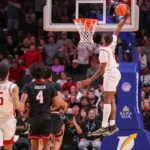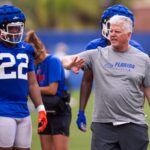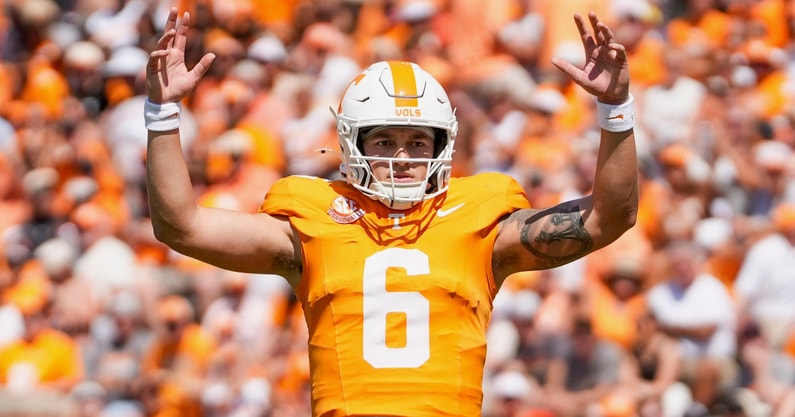After a week to regroup (and laugh at Texas’s misfortune), the Hogs are back in action on Saturday against 12th-ranked Tennessee in Knoxville.
Two new pieces of news have hit since Monday’s The Week Ahead post.
Arkansas’ deal with Blueprint Sports is no more. Blueprint is the firm hired by the Razorbacks to run the Arkansas Edge NIL collective, which has mostly been a failure. The attempted “Drive to 5K” (5,000 monthly donors) quietly ended well short of the goal, and over the last few months, Edge has had just one permanent employee and no director.
The timing is interesting, because Blueprint was in the news late last week after Oregon State revealed details of their deal, which is horrible. Depending on donation levels, Blueprint could end up pocketing up to 45% of contributions made by donors. (For the record, Trey Biddy reports from a source that Arkansas’ deal is “not at all structured like that”). Once representing more than 20 universities, Blueprint was down to six as of late last week. Make that five now that the Hogs are out.
Everyone is still figuring out how to manage the new world of NIL, but these external vendors look more like vultures than experts with usable domain knowledge. I don’t know what’s next for Arkansas’ NIL operations, but my guess would be bringing Edge in-house.
Arkansas interviewed Kirby Moore. Missouri’s offensive coordinator isn’t going to be a candidate that excites Razorback fans at all, but Hawg Beat’s Riley McFerran confirmed that the Razorbacks interviewed him this week.
Kirby is the brother of Kellen Moore, the former Cowboys backup quarterback and then offensive coordinator. Both played at Boise State. Kirby was Kalen DeBoer’s offensive coordinator at Fresno State and is in his third season at Missouri.
I had heard of him and been impressed by his work prior. Missouri finished 67th in Offense SP+ in 2022, the year before he was hired, and has finished 13th and 23rd in his two full seasons. The Tigers are 11th this year. Missouri does not have any kind of resource advantage and there’s no real reason why the Hogs should not be able to match the recent success that Eli Drinkwitz and staff has had. (It would help if the SEC would give Missouri’s conference schedule to the Hogs, but that’s a different story.) I do think it’s more likely that he starts as the head coach of a smaller school, not in the SEC.
There are plenty of reasons why Arkansas might want to interview a guy who they have very little intention of hiring. First, Moore might share an agent with a guy the Hogs do want. Boosting Moore’s resume by granting an interview could be the price of talking to one of the agent’s other clients. Second, sitting head coaches won’t do in-season interviews. So Hunter Yurachek can sit around twiddling his thumbs until November or he can start talking to guys who are willing to talk to him right now. And third, Yurachek can learn a lot about what other coaches think about the Arkansas job by talking to active coaches.
Bigger names will be attached to this job, but Hog fans may have to wait a little while to start hearing about them. In the meantime, we’re keeping our coaching candidates post updated with new information.
- Box Score Breakdown: Arkansas 93, Texas Tech 86

- Box Score Breakdown: Arkansas 82, Fresno State 58

- What to expect from the Ron Roberts defense

Meet the Vols
The last time we met Tennessee, the Vols were slinking off the field in Fayetteville as fans rushed in following a 19-14 Razorback victory that ended with Nico Iamaleava executing the rare Bartleby the Scrivener Hail Mary on the final play.
Along with the 2021 Texas game, this game served as the closing bookend of the Sam Pittman era.
For Tennessee, a lot has happened since then. The Volunteers stopped hyping their quarterback and focused on the run game and defense after the game. They went 6-1 over the final seven of the regular season, snuck into the playoff, and got blown out by eventual champion Ohio State.
Then this spring, Iamaleava made the strange decision to enter the transfer portal after apparently demanding more NIL money (he was already reportedly making more than a million per year). The Vols called his bluff and let him walk, and he ended up at UCLA, where struggling coach DeShaun Foster needed a big splash. The saga ended up pulling Madden Iamaleava away from the Hogs, as he followed his brother. Iamaleava’s adventure in Los Angeles is another story for another day, but the Vols ended up swapping quarterbacks with the Bruins, taking Appalachian State transfer Joey Aguilar, who spent the spring at UCLA.
Through six weeks, it is clear that Tennessee won the tradeoff. Aguilar has been solid, while Iamaleava has mostly been a disaster outside of last Saturday’s stunning win over Penn State.

There have been no shortage of points in Tennessee’s five games, as the Vols are scoring but also allowing plenty of offense each week. They’ve already played a pair of overtime games, splitting them.

Model pick: Tennessee 36, Arkansas 34. As you can see, the model is unimpressed with Tennessee’s defense. Every FBS opponent has scored at least 24 points on the Vols. If the Razorback offense comes to play, the Hogs should be able to stay with in the 13.5-point opening spread.
All of the numbers in our tables are opponent-adjusted, and so Tennessee’s 92nd-ranked strength of schedule is dragging their performance down across the board.
When Arkansas has the ball
Tennessee’s defense was dominant a year ago. I expect that it is actually much better than the advanced stats suggest, but so far, the Vols are struggling to limit opposing offenses.
Here is a basic alignment, with ProFootballFocus player grades:

The Vols will mostly align with 3-3-5 personnel and will often drop a linebacker – typically either Arion Carter or Edwin Spillman – into the box as an additional edge rusher. PFF loves the Vols’ front ten and thinks the safeties are the problem with the defense. As we’ll see, our in-house advanced stats largely agree with that assessment.
Injuries have also plagued this Volunteer defense. Both expected starting cornerbacks from the preseason are out: all-SECer Jermod McCoy tore his ACL in January and has yet to play this season, while other starter Rickey Gibson III hasn’t played since an injury in the season opener against Syracuse. Neither will play on Saturday. Defensive tackle Daevin Hobbs, however, is set to make his season debut against the Hogs, although he’ll likely be limited. The Vols are hoping that getting key guys back from injury might help improve a defense that has struggled.

Tennessee is struggling to prevent quality drives (6.6 opponent drives per game get inside their 40, 121st) and are struggling to prevent opponents from finishing those drives with points (4.6 points per opportunity drive, 119th). If the Hogs can avoid turnovers – a major if – they should have no problem moving the football.

There are a lot of numbers here, but they tell a pretty coherent story. The Vols are struggling to prevent successful plays both on the ground (107th) and on early downs (107th), and they are giving up way too big plays both through the air (86th) and on passing downs (95th). Basically, opponents are using the run game to stay on schedule and pass game to hit big plays.
We saw this in Tennessee’s last outing, against Mississippi State. The Bulldogs only averaged 4.5 yards per rush and 3.7 yards per play on standard downs, which looks really good for Tennessee.. but 23 of their 50 rushes gained at least four yards and 23 of their 50 standard downs were successful (“successful” means the play had a positive EPA, so it increased their expected points). Despite all that efficiency, only four out of 50 standard downs were explosive (“explosive” means runs of 10+ yards or passes of 20+), hence the lower yards per play. This “hidden efficiency” which you won’t see in the regular box score is how State was able to put up 34 points despite some unimpressive total yardage numbers.
Here’s another view, breaking out standard downs against passing downs:

The Hogs are just dominating standard downs (even in the ugliness of the Notre Dame game, the Razorback offense still recorded 23 successful plays on standard downs), while Tennessee is all over the place. Here again you can see the Vols limiting big plays on standard downs (21st) but getting torched on passing downs (95th).

Arkansas really needs to run the ball well. The Hogs struggled in the second half of the Memphis game and all day against Notre Dame. They are still clinging to the title of best rushing attack in the country, and now they get an opponent that isn’t great at stopping the run. If the Vols can’t keep the Hogs to under 50% rushing success, then they’re going to have trouble knocking them off-schedule, which probably makes this game a lot closer than Vegas thinks.

The big watchout here is that Tennessee has the strongest pass rush of any team the Hogs have faced this year. PFF charts the Hogs’ improved pass protection with a grade of 78, which is a big improvement over last year. But the Vol pass rush is graded at a very impressive 84. The good things that happen for the Razorback passing attack have been very good: 14th in success rate, 10th in explosive play rate. But as has been the case for several years for the Razorback offense, the bad things are often very bad: five interceptions, and six sacks, with four coming in the last two weeks.
The downside of that is what we saw in the poor PFF grades for the safeties above: Tennessee is getting burned plenty of times when it brings extra rushers.
Strategically, this Tennessee defense has the same overall profile as last year’s Vols, just a little bit worse. Arkansas needs to get the run game going and stay on schedule, and they should be able to do those two things. Should that happen, and the Hogs also avoid constant turnovers, then this game probably ends up coming down to third down. That will be a boom-or-bust down: expect some sacks and also some big plays, but if the big plays favor the Hogs, they have a real shot to win.
When Tennessee has the ball
I’m very interested to see what the Arkansas defense is going to look like. It has been historically awful to start the season, but Petrino made changes in his first full day on the job, firing co-defensive coordinators Travis Williams and Marcus Woodson along with defensive line coach Deke Adams.
Williams and Woodson, I understand. Their positional responsibilities – linebackers and safeties – have been the most disappointing on the team, and the scheme this year was just bad. Sure, the Hogs don’t have elite talent, but many of the issues this year appear to be X’s and O’s related. There have been guys properly executing the called play and still finding themselves way out of position to make a play. It’s understandable that would eventually become demoralizing, hence all of the jogging and give-up plays we’ve seen this year.
It appears that Williams and Woodson wanted to crank up the aggressiveness this year. They wanted to blitz and play man coverage with tall cornerbacks. Those cornerbacks have mostly been fine, but the linebackers have been constantly out of position and coverages often haven’t made much sense. To quote On3’s Clark Brooks, also known as SEC Stat Cat:
Petrino elevated assistant defensive line coach Chris Wilson to defensive coordinator and then added semi-retired NFL defensive line coach Jay Hughes as a midseason hire to coach the line. Making midseason moves is usually not the best way to get a quick fix, but if the players no longer trust their coaches – or, more likely, Petrino did not trust the coaches – then it had to be done.
Petrino noted that it is too late to re-install the entire defense, so he’s going to focus on simplification so guys can play with more confidence. Coaches talk like this all the time but still have a tendency to make things too complicated.

The Hogs should mostly stick with the Over front and Nickel base that Williams brought with him. Again, it’s probably too late to make a wholesale change to something else, and that base look probably isn’t the problem anyway.
Wilson is now coaching linebackers, and he’s got to get something figured out. Xavian Sorey was supposed to be a star, but PFF says he’s the worst player on the defense. Safety Larry Worth also has not taken a step forward this year like we expected. Defensive line has been excellent, which makes the firing of Adams so surprising. There must have been something else going on there.
Tennessee’s offense looks like Arkansas’: star quarterback, star receiver, star running back. Offensive line and support cast are pretty mediocre. The Vols want to have Aguilar throwing the ball to Chris Brazzell II and handing off to DeSean Bishop (or talented backup Star Thomas), and everything else is just filler.

The Tennessee offense is a consistent machine. Like old Art Briles Baylor offense on which it is built, the Vol offense focuses on using the run game to stay on schedule and finding big plays in the passing game. As solid as they’ve been this year, they have sprung a notable leak of late: Aguilar has tossed five interceptions this season, all of them in the last three games. Georgia and Mississippi State each got him twice, and UAB also got him once. That might be worth watching, especially if the Vols aren’t completely sure what to expect from the Razorbacks’ hopefully-revamped coverage.

The Vols are built on bending you and eventually breaking you. They are very good at staying on schedule (71% of plays come on standard downs, 19th) and creating new first downs without reaching third down (18th). They do not get a ton of explosives (50th on standard downs, 65th on passing downs), but the offense gets the job done.
Arkansas, meanwhile, has been a horror show on passing downs. Absolutely no down-and-distance is safe for the poor Hog defense. They’ve been competitive on standard downs, which is worth watching against a Tennessee team that mostly built on winning those situations.

This chart gives a good look at the consistent efficiency of the Vol offense. Their only major weakness is that their run game doesn’t generate many explosives (102nd), but they do have a general ability to keep the ball moving despite not really being elite at anything.

Part of Arkansas’ scheme issues are evident in this chart when you see the difference between the advanced stats up top (75th in opponent EPA per rush, 83rd in opponent rushing success rate, 116th in opponent rushing explosiveness) and the stats below. The Hogs are not a good run defense at all, but they are not bad at any particular thing except for letting too many good runs (46% of runs go for 4+ yards, 54th) turn into great runs (17% of runs go for 10+ yards, 116th), which is on the linebackers and secondary, as you can pretty obviously tell from the PFF grades above.
The good news for the Hogs is that Tennessee’s offense doesn’t turn too many of its good runs into great runs. The Vols are very good at not going backward and using the run to stay ahead of the chains, but they aren’t turning in a bunch of explosives.
As we saw last year, much of Tennessee’s run game is RPO-based. The Hogs confused Heupel and Iamaleava last year by using Dime personnel and dropping the read man into the box as a run defender at the very last second. This exposed the RPO game’s biggest weakness: it doesn’t use all of the field. The Vols had numbers in other places, but the read went right into areas the Hogs could defend.
Tennessee has since adjusted to that look. The Vols eventually got better at attacking it last year, and they’ve learned to be more patient than they were in the Hendon Hooker days when they were constantly looking for the next explosive pass. As we see in the numbers, they are run-heavy and focused on taking what the defense gives them.

Aguilar has been pretty much what Tennessee fans thought they were getting with Iamaleava. He throws a good deep ball and has been all-around accurate. Our model thinks poorly of the competition, hence none of these numbers being in the top-25. Still, there are no real weaknesses here, and the Hogs have allowed explosive plays by the dozen through the air this year.
Keys to the game
Back to basics on D. Improved effort and run fits have to be worth something for Arkansas. The Hogs are not going to shut down any offense left on the schedule, and certainly not this Tennessee offense. But just a few stops might be all it takes to make this a close game. Containing the Tennessee run game with better run fits, getting a little bit of pressure, and being in position to take advantage of any interceptible passes out of Aguilar’s hand are all reasonable goals.
Fireworks on third down. Arkansas’ offensive output is going to come down to how they do on passing downs (mostly third/fourth down and four-plus yards to go). Tennessee gets plenty of stops but also allows plenty of big plays due to the aggressiveness of their defense. Petrino has long been a dominant third down playcaller, but can his team execute in a hostile road environment?
